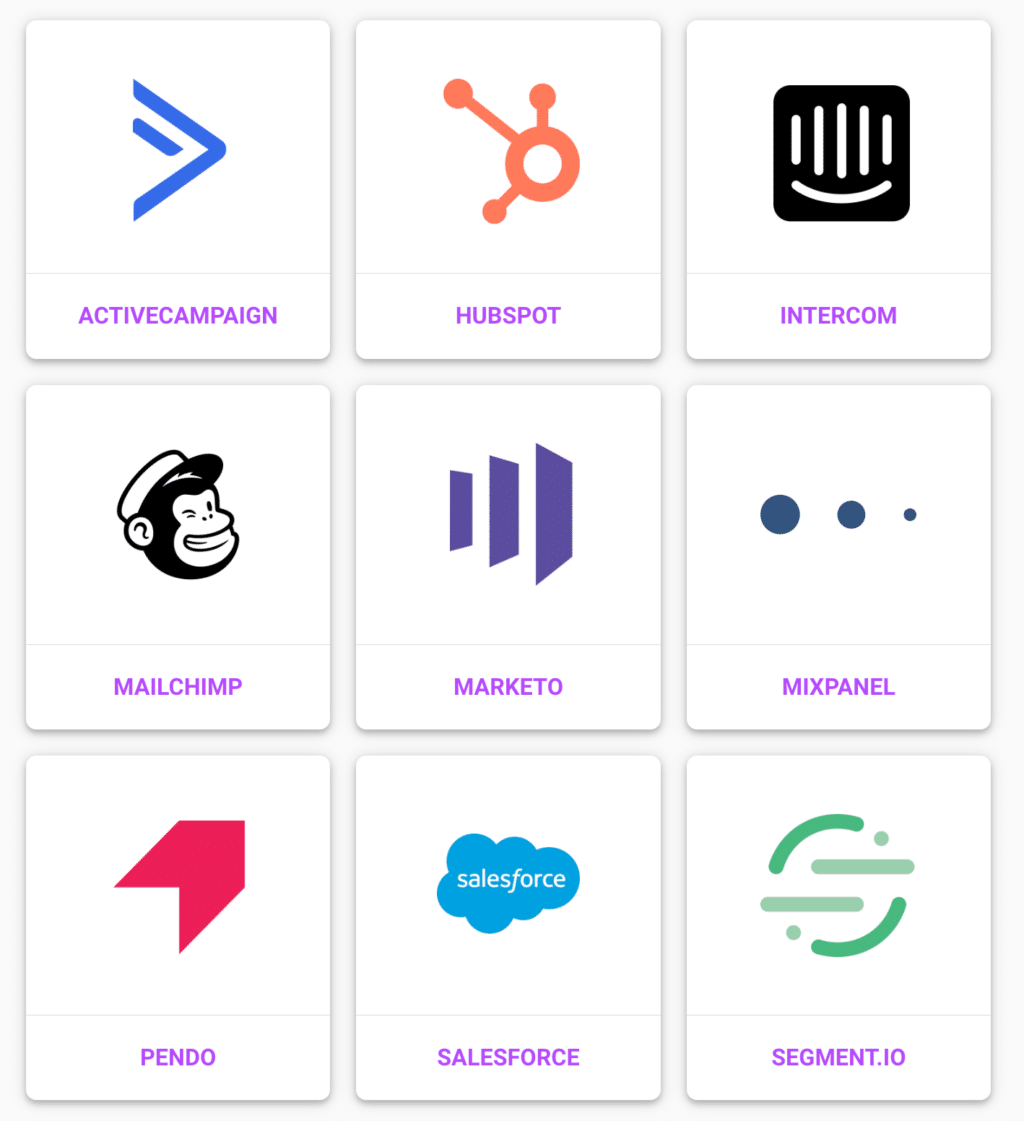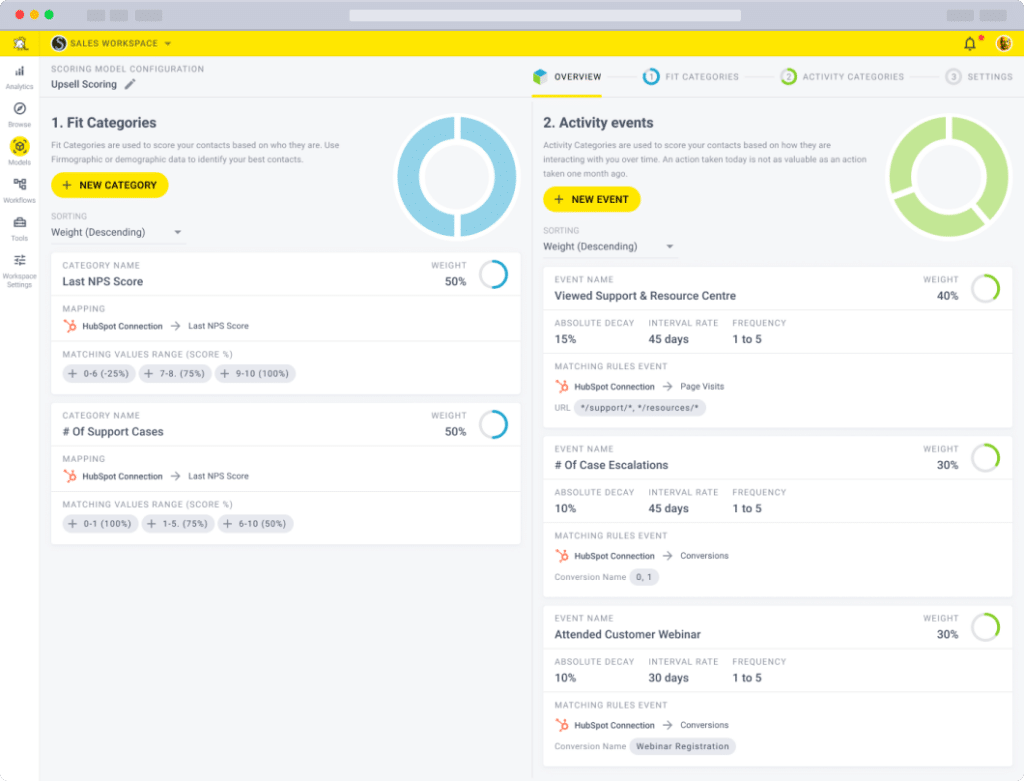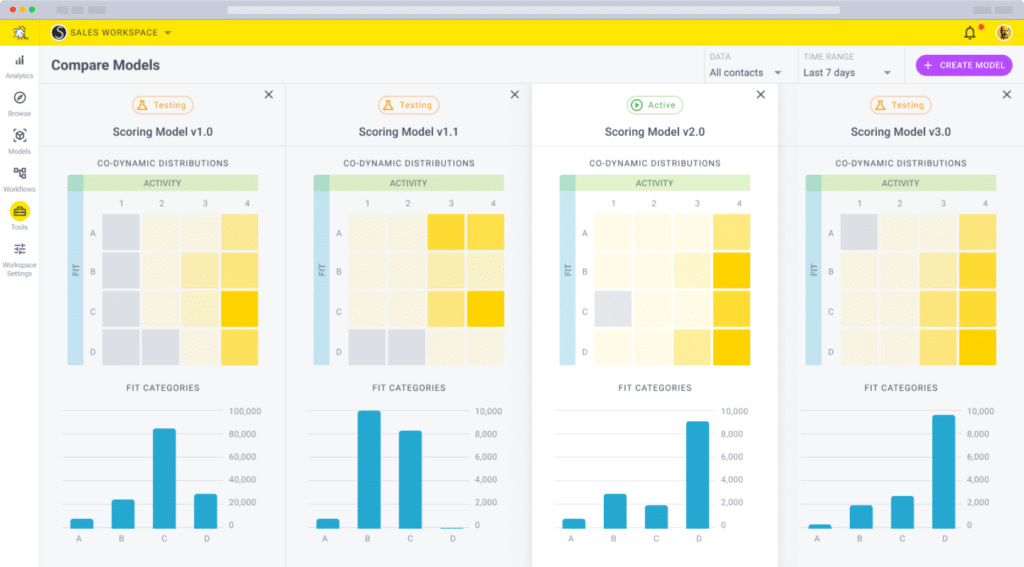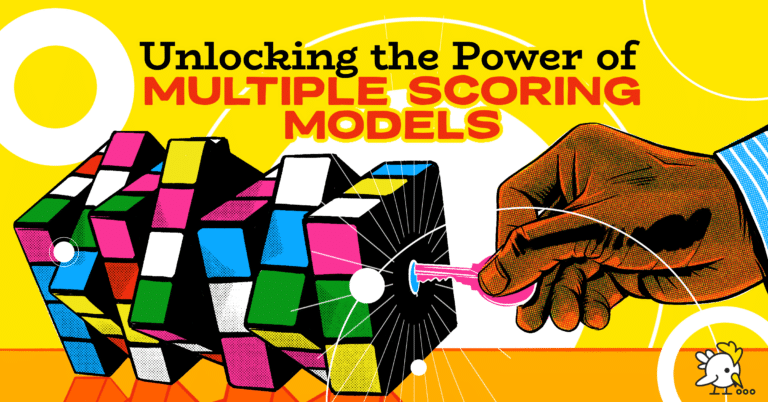Traditional lead scoring software (which, unfortunately, some brands still use today) had a lot of limitations.
The models were static, meaning that as soon as a lead took a specific action, they were attributed points that never declined over time… even when they should have. They also had a tendency to focus on fit or activity, but rarely both, even though both are essential for an accurate lead score.
And, perhaps most importantly, most traditional lead scoring software focuses on a single scoring model. This is almost always to their detriment.
Here at Breadcrumbs, we strongly believe you need more than just one measly scoring model, and in this post, we’re going to tell you why.
Do I Really Need Multiple Lead Scoring Models?
Short answer: Yes, you need multiple lead scoring models, and you’ll thank us once you do.
A study by Demand Gen Report found that companies using multiple scoring models had a higher success rate in terms of meeting revenue goals than those that only used a single model.
Another study by Aberdeen Group found that best-in-class companies are 40% more likely to use multiple lead scoring models, especially compared to their peers.
We’ve seen this ourselves time and time again, both with internal usage of our lead scoring models and with the models our clients are creating.
So How Many Lead Scoring Models Do You Really Need?
This is an important question. You don’t want to end up with so many models that the data becomes confusing, but you want to have enough lead scoring models that you’re actually getting actionable insights.
The number of lead scoring models you need will depend on a number of factors, including:
- The size of your company
- The diversity of your target audience (including the number of audience segments)
- Your sales process
In most cases, large companies or those with extremely diverse target audiences are going to need more lead scoring models. Complex sales processes may also require additional scoring models.
In general, having two to three lead scoring models can provide more comprehensive insights and result in improved decision-making, as you can set up dedicated models for different purposes. The more detailed your lead scoring models are (and the more specific their purpose), the more actionable the data becomes.
Let’s take a look at a few examples of how businesses may use different types of lead scoring models.
-
What Is Lead Scoring?
Read more: What Is Lead Scoring?Lead scoring is the method of assigning points to contacts or potential prospects based on…
-
What is BANT?
Read more: What is BANT?BANT is an acronym that stands for Budget, Authority, Need, and Timeline. It is a…
-
What is lead qualification?
Read more: What is lead qualification?Lead qualification is a systematic process utilized by businesses to evaluate potential customers based on…
1. Incorporating Different Data Sources
Lead scoring becomes more valuable when you’re able to take in as much information as possible. Part of that process, though, is to evaluate different data sources and to understand how it does or doesn’t impact the efficacy of your lead score.
You may, for example, want to create different lead models to account for data sources that provide information on website behavior, social media activity, or demographic information. You do want to combine these data sources in most cases to get a complete picture of a lead’s potential value (and tailor your marketing and sales strategies accordingly).
If you’re unsure about the data quality, however, you can use different models to test the impact of different behaviors that are coming from different data sources. Here at Breadcrumbs, we offer multiple data sources thanks to seamless integrations.

2. Fine-Tune Your Targeting
Depending on your business’s goals, it makes sense to prioritize certain types of leads over others. This is part of what makes lead scoring so valuable— your team can easily identify the highest-value opportunities that are most likely to convert so that you can focus your energy there.
Lead scoring models can help you fine-tune your targeting. You may, for example, have a lead scoring model that focuses on lead quality, prioritizing how likely an individual lead is to convert. Meanwhile, you’d have another that focuses entirely on lead velocity, which indicates how quickly they’re likely to convert.
You can learn more about what types of leads fit into each category, including which firmographic and activity indicators could help you flag high-value leads.
Creating lead models that flag different high-value priorities is also smart because it can help you balance your short-term and long-term revenue goals, allowing you to make smarter and more informed decisions when you’re choosing where to allocate your resources.
3. Assess Different Parts of the Digital Sales Funnel
While it’s typically called “lead scoring” and the focus is on prospects who haven’t yet converted, we actually call it “contact scoring” here at Breadcrumbs. That’s because you can use different models to identify opportunities and clients that are what we’ll call “high flight risk” throughout the entire sales funnel.
You can create models focusing on identifying high-value or high-velocity leads, as we’ve already discussed. You can also create lead scoring models that are dedicated entirely to cross-selling or upselling so that you can increase your average customer lifetime value. And you can even set up a contact scoring model that flags existing customers who have a high chance of churn based on factors like multiple support tickets and disengagement from the product.

Converting leads into customers is great; customer acquisition is obviously an essential part of growing a business. Accelerating revenue, however, requires more than signing a bunch of one-time deals. The ability to not only land new customers but successfully retain existing ones thanks to contact scoring is often under valued, and it shouldn’t be.
4. Adapt to Changing Market Conditions
As nice as it would be to figure out a market and be able to leave well enough alone, that’s almost never the case. Market changes can happen fast, and they typically happen often, as markets constantly evolve for a number of different reasons.
What works today may not work tomorrow, and the ability to create multiple scoring models can help you with that.
By having multiple scoring models, you can test different hypotheses surrounding your buying cycle, your customers, and your product’s USP. You can adjust strategies as needed so you can stay ahead of the competition, even if that competition is actively changing.
You may, for example, have a scoring model that’s optimized for a specific product or service, and another that is more generalized. You can learn a great deal from these different models, helping you stay ahead of the curve by identifying new growth opportunities.
5. Testing
Creating a lead scoring model is both an art and a science, which means that it may take a few tries to get it right.

We typically recommend testing lead scoring models extensively, starting out with a few core data points that you know are good indicators of success. You don’t need a ton of data to get a good lead scoring model, especially when you’re starting out. Once you’re onto something, you can create a split test model that incorporates another data point to see how successfully it assesses lead quality.
By continually split-testing different models, you’ll gain enormous insight into which data points most indicate a lead’s quality.
-
Lead Scoring vs Lead Nurturing: 7 Differences to Maximize Your Sales Funnel
Read more: Lead Scoring vs Lead Nurturing: 7 Differences to Maximize Your Sales FunnelManaging leads effectively means prospects move through the funnel efficiently, resulting in more conversions and…
Use Multiple Scoring Models Today
If you’re wondering why more businesses don’t use multiple lead scoring models, there are a few simple answers.
The first is that some tools don’t offer the ability to create multiple models. You can create one model, sometimes restricted to either fit or activity, and often in a static way that doesn’t account for recency. They’re locked into one model, and don’t realize there are tools that allow for more.
The second reason, which is perhaps the most common, is that multiple scoring models do require more effort and resources. It can take time to set up different scoring models and to continually test, and it may take time to train your sales team how to use and prioritize results from multiple models. That being said, the investment of time and energy is well worth the increased revenue you’ll see as a result. Your team will have much more actionable information, and they’ll be able to make better decisions faster.
So, if you’re currently using the one-model approach to contact scoring, take this as your sign from the universe: It’s time to explore the possibility of adding one or two more to your arsenal. We’ve seen firsthand how powerful of a tool it is for businesses to unlock additional revenue and take their business to the next level.
Want to learn more about how Breadcrumbs can help you with revenue acceleration? Book your free demo here.



